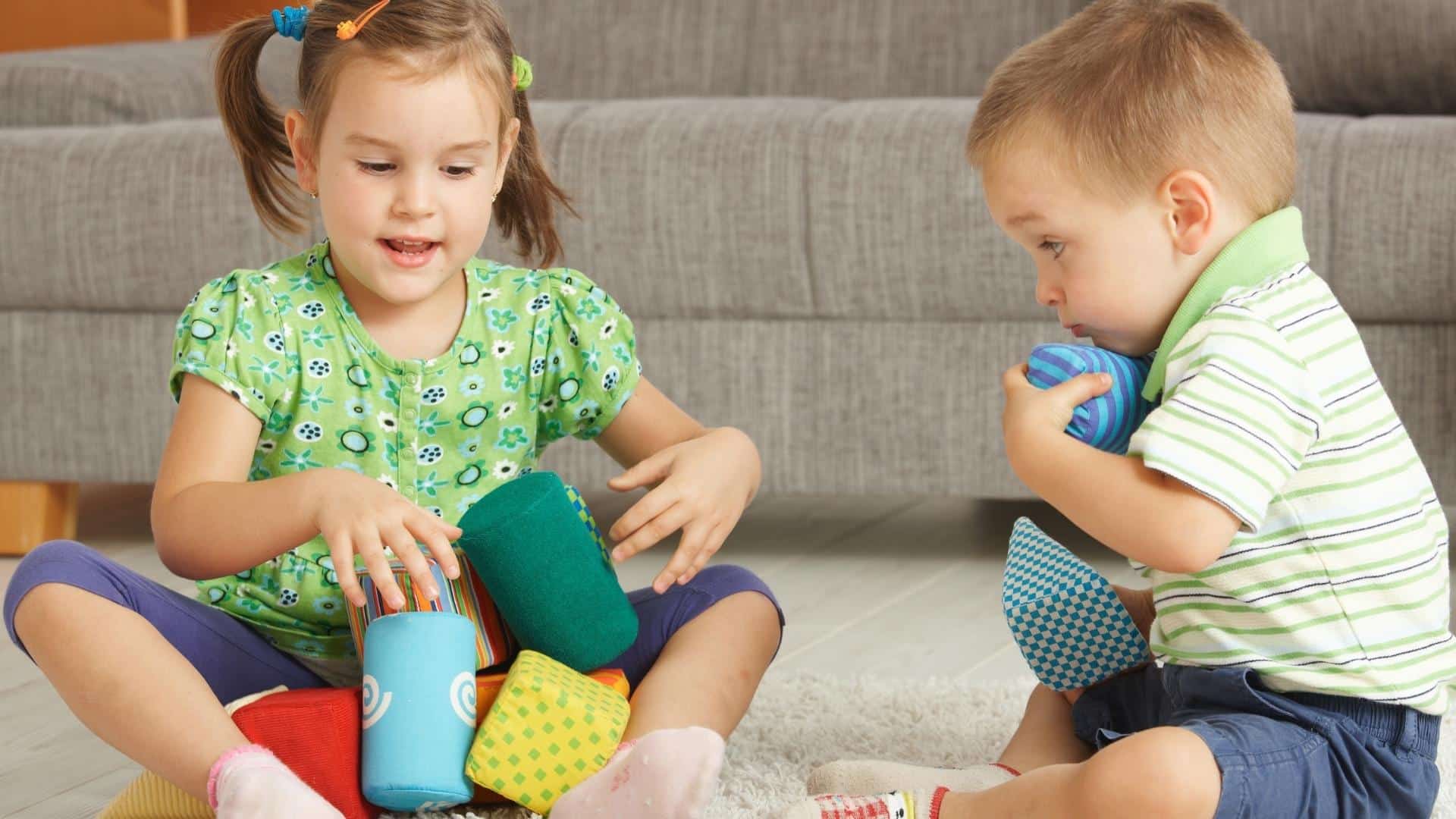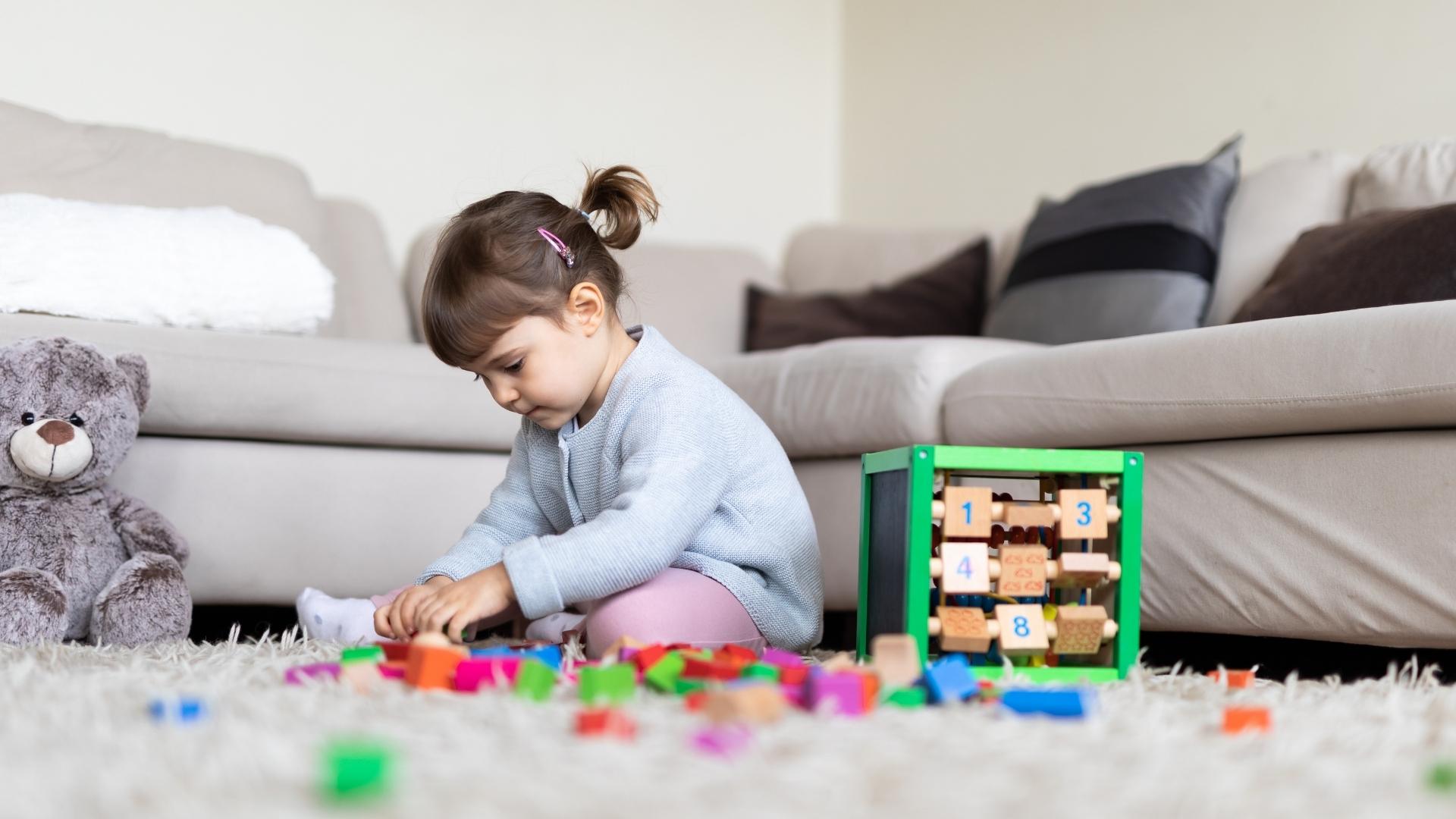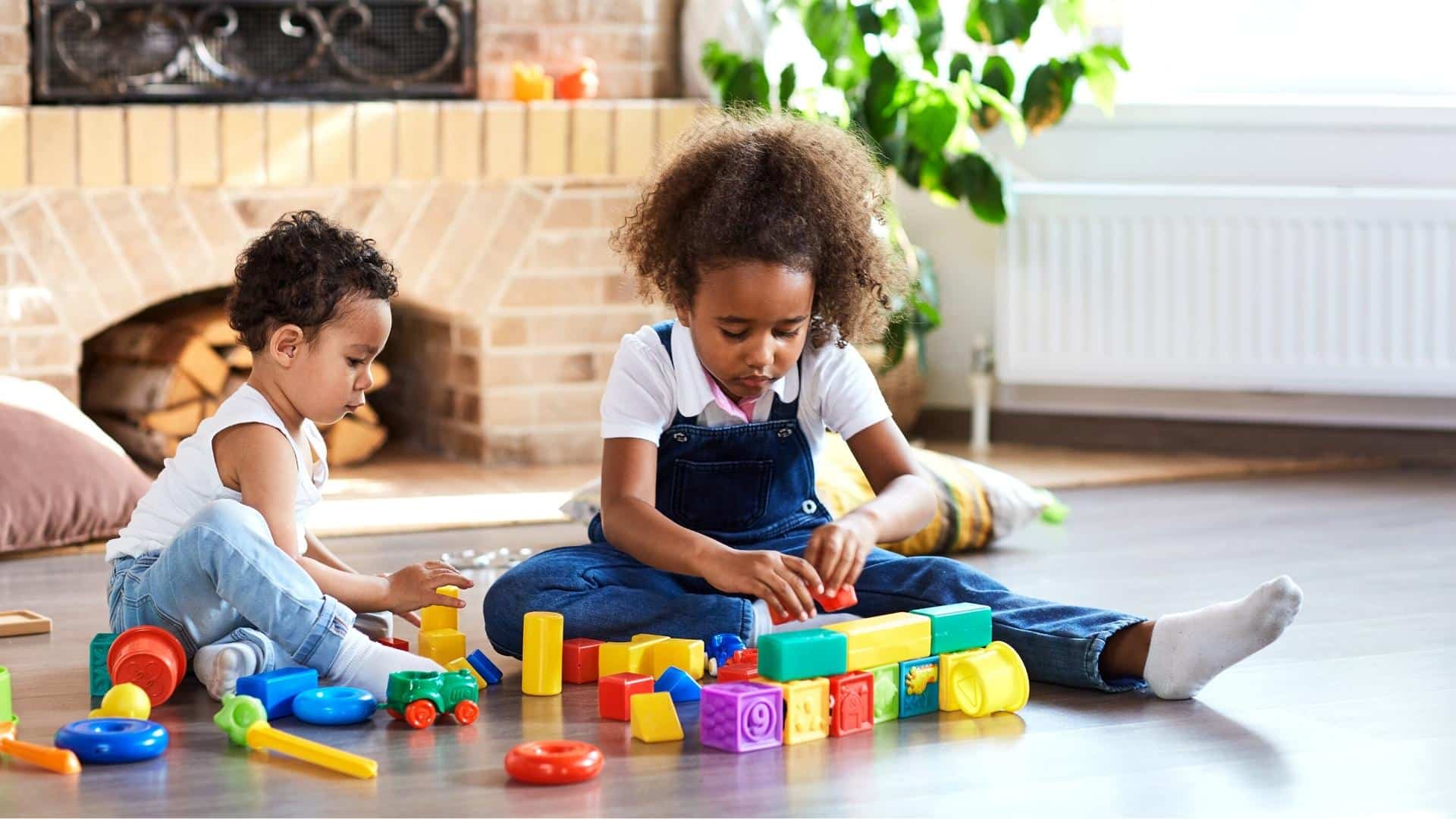Are you a parent who’s curious about your child’s social development? Have you ever heard of parallel play, but aren’t quite sure what it is or why it matters?
Look no further! In this article, we’ll explore what parallel play is, when children typically engage in this type of play, and how it differs from other forms of play. Plus, we’ll share some examples of parallel play and the main benefits it offers.
Parallel Play Definition
Parallel play is the 4th stage of play when children will play alongside each other, but independently. They will play with similar toys, mimic one another and share the same space, but they will lack a group focus during their play sessions.
Characteristics Of Parallel Play
The parallel play stage is characterised when children do the following:
- Observing and copying. During playtime, children will often mimic what other children are doing by engaging in the same type of play or by copying their actions.
- Playing alongside other children. Children engaged in this type of play will happily play alongside other children, make eye contact and enjoy being in their company… but they do not actively engage or participate in another’s play.
- Playing independently and not be inclined to share. During parallel play, your little one will still not be inclined to share their toys and they will prefer to play on their own. This is a skill that will come later in their social and cognitive development.
- Show emerging social skills. As time progresses, your child will learn a lot from their parallel play observations and their social interation skills will start to emerge as a part of their healthy development. This includes cognitive skills and communication skills too.
Why Is Parallel Play Important?
Parallel play is important for children because it allows them to gain the confidence and knowledge to move from solitary play toward cooperative play in a non-intimidating and safe way.
Children engaging in parallel play will now start to develop and see themselves as part of a social group, but they will still be very self-centred. This is a very important transition to move through as it will form the basis of how children will play socially with others in the future.
Parallel Play Age Range
Typically, children will engage in parallel play between 2½ and 3½ years old, but it usually fades out 4 years old. However, some children will continue to fall back into parallel play habits as they grow because they feel safe playing this way.
The Six Stages Of Play Recap
Here’s a quick recap of the 6 types of play you can expect your little one to engage with during the early years.
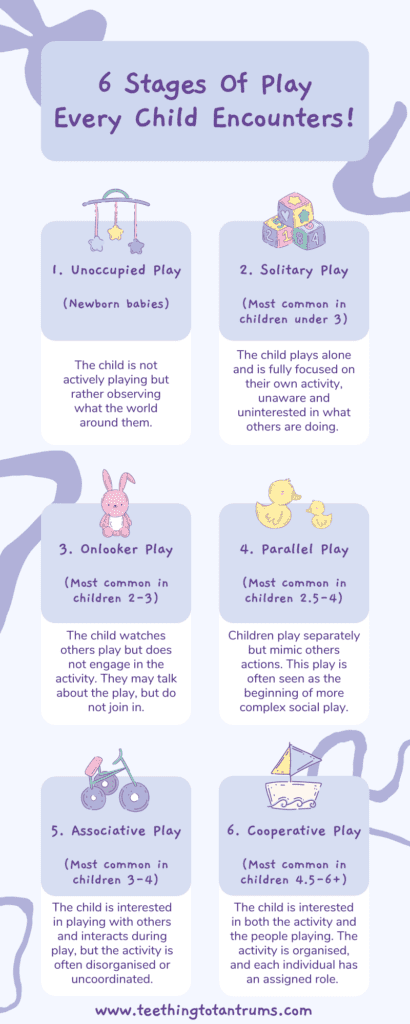
- Unoccupied Play (0-3 months)
- Solitary Play (most common in children under 3 years)
- Onlooker Play (most common in children aged 2-3 years)
- Parallel Play (most common in children aged 2.5-4 years)
- Associative Play (most common in children aged 3-4 years)
- Cooperative Play (most common in children aged 4.5-6+ years)
To learn more about Mildred Parten’s 6 stages of play, I’ve written an in-depth post talking about each stage and why they’re important for children. So be sure to check that out after reading this post here.
What Is The Difference Between Parallel And Associative Play?
Parallel play differs from associative play with one key difference… How children interact with each other.
During parallel play, children will not engage with other children but they will be happy to be alongside them all whilst doing their own thing.
On the other hand, associative play is when children will start to comment, ask questions, and interact on a minimal level. You may begin to notice your child share their toys during associative play too.
TOP TIP: Stages of play do not happen in isolation and will often overlap and be ever present even as your child grows up.
Parallel Play Benefits
Even though parallel play is independently based, there are still many benefits your child will gain by engaging in this type of play:
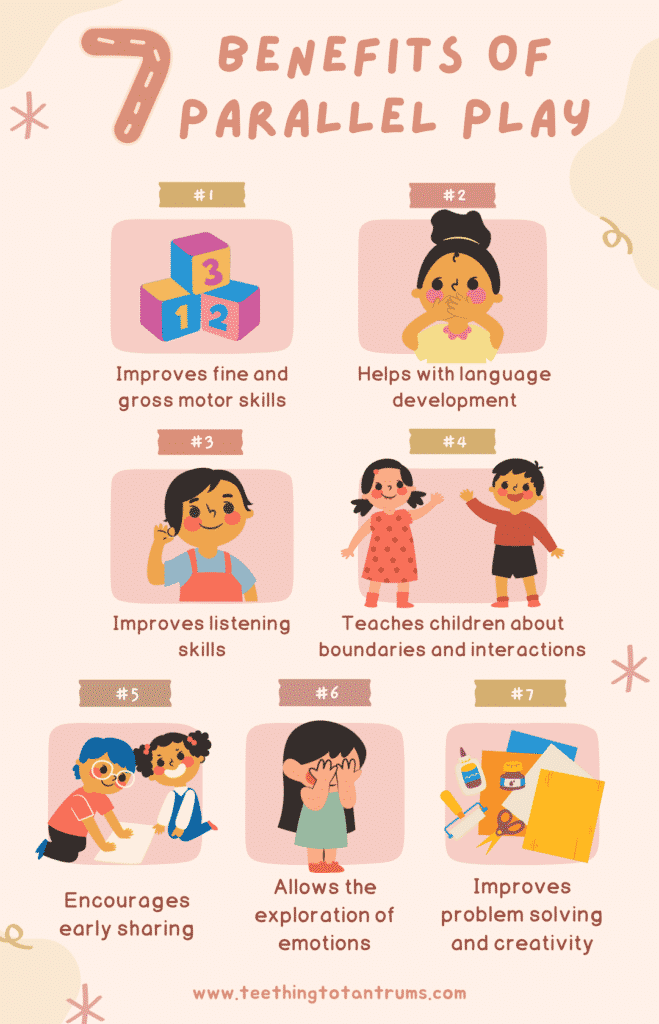
- Improves gross and fine motor skills. Play is all exploration and investigation. So whether it’s through sand play or painting, your little one’s motor skills will be thriving every day.
- Helps with language development. As your little one observes and listens to others, they will be increasing their vocabulary and learning how to use new words every day.
- Improves listening skills. Along with developing language skills, engaging in parallel play will also greatly improve your child’s listening skills as they watch and observe others interact, share and work towards a goal.
- Teaches children about boundaries and social interaction. Your child will watch and learn how other children respect boundaries, socially interact, and be nice to one another.
- Encourages early sharing. Watching others during this type of play will teach your child how to understand the concept and benefits of sharing. Now is also the perfect time to introduce books that explain the action of sharing at bedtime.
- Allows the exploration of emotions. Children going through parallel play have the opportunity to explore lots of emotions: from joy to frustration, wonder to sadness. They need this time to learn how to process and deal with these feelings themselves before learning how to take others into consideration during associative and cooperative play.
- Improves problem-solving and creativity. As children watch how others work together to get things done and observe how they can achieve different results when doing the same activity alongside them, they will learn a wealth of new skills every day.
Looking to get your little one to sleep quickly and effortlessly? Check out my Bedtime and Nap Cheat Sheet and master the art of making daytime naps and bedtimes as seamless as possible.
A bedtime & nap cheat sheet so good your little one will ask you to put them to bed...
Laura Williams "This is a life saver! I'm so glad I downloaded your bedtime & nap cheat sheet. My little one actually asked me to put him to bed last night! Unbelievable! Thank you so much!"
Click Here For The FREE Cheat Sheet
Parallel Play Activities And Examples
As parents, we can encourage parallel play by simply providing the right play opportunities and cooperative games.
And as with all stages of play, it takes practice, so ensuring that you give your child the time and opportunities to play with others is hugely important.
Try the following parallel play games:
1. Draw Or Paint A Picture Together
Setting up a creative activity such as painting or drawing where you both create a picture next to one another (separately but using the same equipment) is a great way to expose your little one to parallel play.
Comment on what they are doing but don’t interfere or sway them to create a certain image. Let them watch and comment on what you are creating and enjoy the process.
2. Organise A Playdate
Exposing your little one to social situations with one or two other children is a great way to start introducing your child to this type of play too. Your child can then safely play alongside other children and observe what they are doing at their own pace.
Physical activities such as going to the park or visiting a play centre are all wonderful options to encourage parallel play.
3. Play With Building Blocks
Putting out a substantial set of building blocks and encouraging children to use them to build block towers is another great way to facilitate parallel play.
Each child can use the shared blocks to produce their own creations whilst in each other’s company. This 100-piece wooden block set from Melissa And Doug is simply perfect for these occasions.
No nursery is complete without wooden blocks. They provide hours of fun and education through play from honing fine motor skills, improving problem-solving, developing creativity and teaching colours and shapes. My favourite is this colourful set from Melissa and Doug.
4. Explore Through Sand And Water Play
Sand and water play are brilliant parallel play activities because children do not need to work together to get the most out of these games and they can happily play independently alongside each other and observe and comment on what each other is doing, should they so wish.
5. Visit A Playgroup
In a playgroup situation, encourage your child to watch what the other children are doing so they learn social behavior cues.
You can even engage with the other children by asking questions about what they are creating or playing with whilst your little one observes the interaction. This is great to show your child how parallel play works.
Occasionally, you may need to take the lead and go and sit near other children and play alongside them until your little one feels comfortable doing it alone.
REMEMBER: Don’t force your child to play alongside others if they are not ready. Although children move forward through the 6 stages of play, they will still engage in previous stages at times. Therefore, they will often engage in solitary play or stand and observe a situation before engaging in this type of play.
Best Toys For Parallel Play
Below are some of my top toys to help encourage your child to engage in some social activities:
1. A Sand Pit. Boost your little one’s fine and gross motor skills whilst helping them learn how to play alongside other children with a sturdy, long-lasting sensory sand pit.
I love that this table has a tough moulded lid that ensures the sand stays dry during wet weather but means your child can still play with the table regardless!
I also love the durability and easy-to-clean design of this sandpit too. It's perfect for sensory exploration for children of all ages!
2. A Wooden Toy City Set. As well as Melissa and Doug’s 100-piece wooden block set, you can open up the opportunity to boost your child’s cognitive and sharing abilities by encouraging them to create a wooden town alongside their peers.
Offering endless possibilities to create a city alongside one another, your toddler and their play companions will love this wooden building block set. BPA-free, lead-free, phthalate-safe and non-toxic, it is also a great choice for parents wanting to choose the best toys for their little ones!
3. A Chalk Set. Love creative activities, but worry about the mess? Let me introduce the amazing world of chalk. Perfect for play playdates, children of all ages will love to create images on the driveway or on paper with a set of vibrant chalk sticks.
Here they can develop their fine motor skills, observe what others are doing and begin to learn the concept of sharing by asking for different colours. Plus at the end of it all, you can simply wash it all away!
This set of vibrant chalk sticks will give your little one endless opportunities to get creative! With an anti-roll shape, washable properties and a bright array of colours, it is the perfect companion for any play session.
3 Common Concerns About Parallel Play
Some children will take longer than others to start engaging in parallel play. This is very normal however, it can lead to some parents worrying that their children are not moving forward socially.
So to put your mind at ease, here are the 3 most common concerns about parallel play and my advice about the situation.
1. My Child Still Engages In A Lot Of Onlooker Play
It is perfectly normal for children to continue to engage in all the stages of play, even after they have reached the age and stage of development at which they can take part in parallel play.
It is important to remember that all children develop at different rates and that continuing to engage in solitary and onlooker play on occasion is a good thing.
Sometimes we all need a little bit of time to ourselves.
2. My Child Is Reluctant To Mix With Their Peers
If your child is reluctant to mix with other children… they may just be shy. Therefore, it may take them longer to start to engage comfortably with others. Allow them the space to go at their own rate.
3. My Child Stands On The Sideline And Observes Instead Of Getting Involved
If your child is standing to one side but showing interest in what other children are doing, allow them time to observe the room and offer to go with them to look at what others are doing. For some children, being around other children can be a little daunting.
However, with you at their side and engaging with the other children, they may feel confident enough to play alongside other children later.
If you are concerned about your child’s developing social skills, then you should consult your paediatrician who, if they think it is necessary, may refer you to a counsellor, child psychologist, child development specialist or play specialist.
REMEMBER: Children will progress through all 6 developmental stages of play eventually, but the pace at which they do so will vary from child to child and will be greatly determined by their personality.
Need More Parenting Help?
- Download our FREE Bedtime & Nap Sleep Cheat Sheet. It’s a free, easy-to-use and proven formula designed for parents of 0-5 year olds to master the art of consistently undisturbed and restful sleep without the yelling, nagging or exhausting long-winded evenings.
- Check out our Parenting Toolbox. You’ll get access to expertly-chosen products that you can guarantee are the best for your little one and your wallet.
- Are you looking for personalized guidance to navigate the challenges of parenting? I offer 1-on-1 consultations to bring you tailored strategies and actionable advice to help support your child's growth and well-being with confidence.

A bedtime & nap cheat sheet so good your little one will ask you to put them to bed...
Laura Williams "This is a life saver! I'm so glad I downloaded your bedtime & nap cheat sheet. My little one actually asked me to put him to bed last night! Unbelievable! Thank you so much!"
Click Here For The FREE Cheat Sheet




